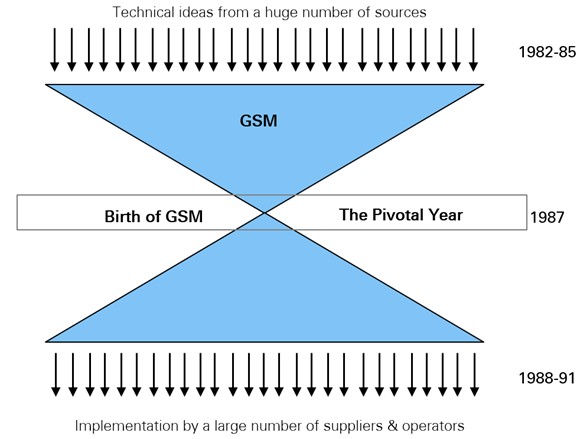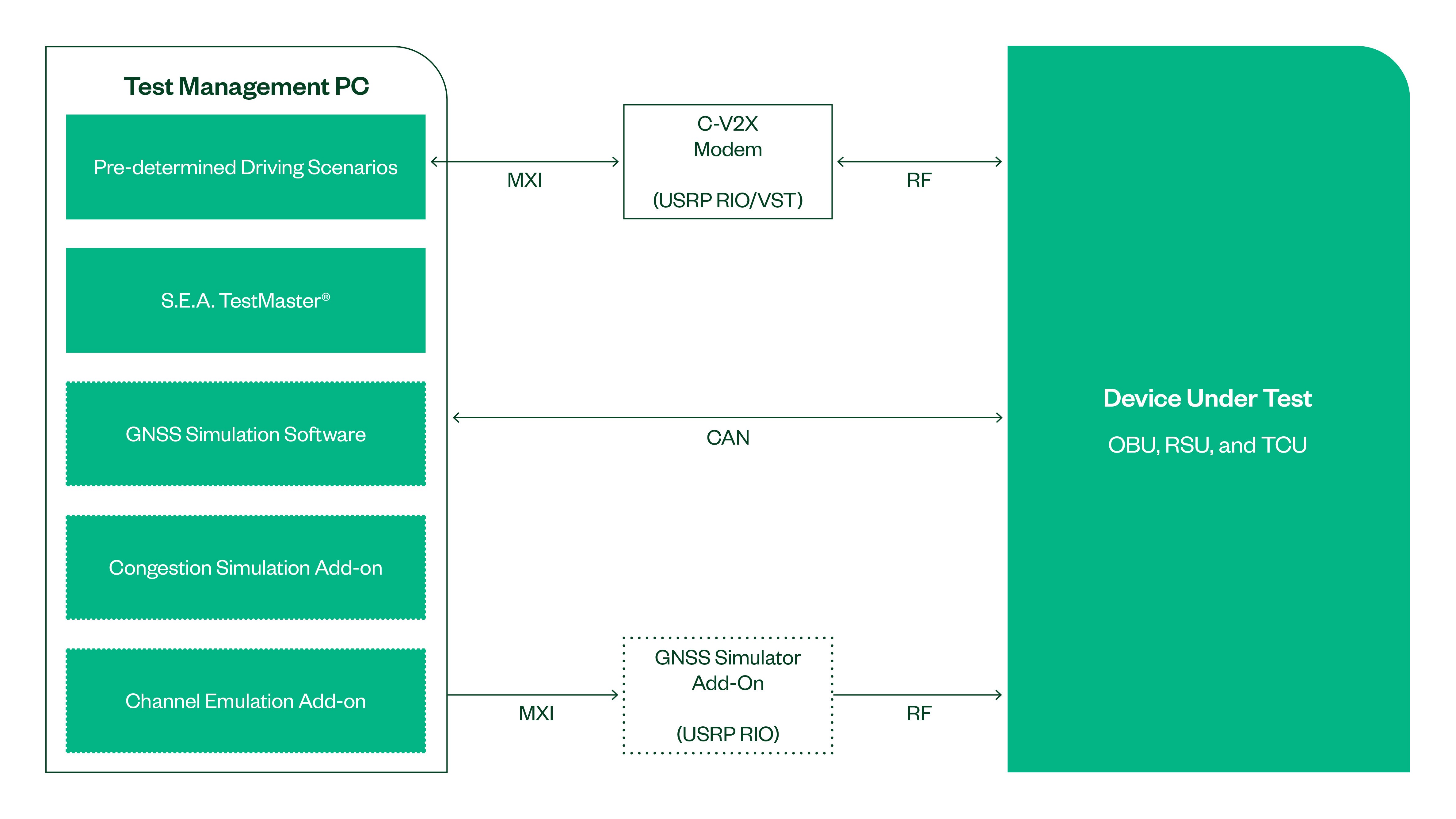A Software-Defined Approach to Rapidly Integrate V2X Use Cases
Overview
Dedicated short-range communication (DSRC) technology once dominated the automotive market—but over the past few years, it’s become clear that fully autonomous vehicles aren’t feasible without widespread 5G cellular connectivity. Recent events, including the FCC assigning part of the 5.9 GHz band exclusively to Cellular Vehicle-to-Everything (C-V2X), will undoubtedly accelerate C-V2X [1]. But with this acceleration comes unpredictability, as standards, applications, and business models are still being defined. To be competitive, automotive OEMs and suppliers quickly need to refine their technology roadmaps to frame technical relevance and product and function integration. And though simulations are important, prototyping new ideas is vital to prove new technology viability.
Contents
- Current V2X Limiting Technology
- How Testbeds Impact Standards
- How NI Can Help
- V2X Tools and Solutions
- Conclusion
- Additional Resources
Current V2X Limiting Technology
As the line between automotive and consumer electronics blurs, automakers are expected to offer systems with a wide range of communication technologies, including 5G connectivity. But 5G deployment depends heavily on standard definition and refining, primarily by 3GPP. As of this writing, 3GPP’s latest release (Release 16) defines 5G phase 2 specifications, which cover use cases such as platooning, extended sensors, and automated and remote driving [2].
However, the aggressive release schedule defines more use cases, which puts pressure on automotive companies to quickly adapt and prototype their C-V2X units based on all upcoming requirements and definitions. This usually translates to a large investment; often, test equipment isn’t upgradeable and companies are forced to purchase new equipment virtually with every major release. At NI, we see this as a test technology challenge, rather than a harsh reality of the automotive connectivity market.
Figure 1: Technology is changing rapidly.
How Testbeds Impact Standards
Just as with previous standards, such as Global System for Mobile Communications (GSM), there is a true race to convergence. A global standardization carries the enormous potential to transform society. Figure 2 shows how GSM started: Contributors vetted ideas and debated until they defined the standard. And, once set, it became ubiquitous and designed into ultimately billions of devices.
Today, C-V2X is at a pivotal moment. Because ideas converge and roll into a standard within a short time, your opportunity to impact that standard is reaching its peak. You don’t want to miss the window to improve differentiation and compete in the market. However, you need a concrete advantage: How can you explore and prove your idea and use-case viability?
Figure 2: Approaching the Pivotal Moment [3]
The answer is clear: By prototyping. As system complexity increases, you can’t prove viability with simulation—you have to use a testbed, or a prototype. Testbeds are common in the wireless community; a National Science Foundation (NSF) workshop concluded, “Experience shows that the real world often breaks some of the assumptions made in theoretical research, so testbeds are an important tool for evaluation under very realistic operating conditions, [the] development of a testbed that is able to test radical ideas in a complete, working system is crucial.” [4]
How NI Can Help
Throughout NI’s wireless-prototyping history, we have seen researchers succeed by selecting software-defined testbed solutions. You can use the same building blocks in the automotive industry:
- NI’s Software-Connected Approach—This is a very effective way to explore C-V2X technologies and prototype them rapidly using unified design software—from simulation through implementation—and off-the-shelf hardware. With software as the core element, you can build the exact systems you need for your application, and as those need change, you can build your ideas in software and protect your investments by reusing your existing hardware.
- NI’s Ecosystem—Utilizing an ecosystem is critical to accelerate testbed development. Unlike closed turnkey solutions, the NI ecosystem offers a jump-start, out-of-the-box C-V2X experience, with the ability to customize and enhance your testbed as requirements evolve. For example, University of Warwick WMG intelligent vehicle researchers developed a connected vehicle simulator environment leveraging NI’s technology and ecosystem.
V2X Tools and Solutions
According to this 3GPP NR V2X work item [5], and as mentioned, there are four primary C-V2X use cases: Vehicle platooning, extended sensors, advanced driving, and remote driving. These require a new NR sidelink communication strategy that supports low latency and high reliability to meet stringent requirements. This strategy would support Multiple Radio Access Technology such as LTE-V2X, NR V2X, and DSRC, and consider frequencies above 6 GHz. Vehicle communication scenario experiments could determine whether it’s possible to incorporate the latest wireless standards. The following V2X tools and solutions offer an expansive ecosystem:
- S.E.A. offers V2X development, test, validation, and verification products and solutions using the NI platform. IEEE 802.11p and LTE-V stack implementations based on NI software defined radios (SDR) handle all manipulation, and the S.E.A. V2X stack supports both wireless access in vehicular environment (WAVE) and ITS-G5. S.E.A. test management software can handle vehicle communication messages such as basic safety messages, SAE J2735, and others.
Figure 3: This S.E.A. V2X testbed is based on an NI SDR platform (image courtesy of S.E.A.).
- With NI software defined radios, you rapidly can prototype wireless communications systems to achieve faster results. Flexible yet affordable SDRs turn a standard PC into a next-generation wireless prototyping tool. Paired with LabVIEW, the NI SDR solution gives you unprecedented hardware and software integration to accelerate your innovation and offers out-of-the-box, standards-based application frameworks for more rapid, focused, component-specific innovation.

- For fully functional V2X solutions, NI has partnered with S.E.A. to save you the hassle and cost of changing test hardware as requirements change so that you can:
- Quickly test Day 1 scenarios or customize your own scenarios
- Perform open or closed hardware-in-the loop V2X subsystem tests
- Test faster and more thoroughly through all-layer test access
- Be ready for all current and future 3GPP standards without costly hardware changes
Conclusion
It is essential to stay informed on technological requirements and remain flexible enough to adapt to changing trends. NI eases the burden by providing you with the capability to refine your technology roadmaps and frame technical relevance and product integration. Using NI’s approach, expansive ecosystem, and best practices from successful wireless researchers can help automotive engineers build a V2X testbed and quickly validate to improve differentiation and compete in the market.
Additional Resources
Learn more about V2X prototyping and simulation:
- Read the case study, “Accurate Emulation of Satellite Signals for a Full-Scale Vehicle Simulator Enables Driving Anywhere Around the Globe”
- Discover NI infotainment and V2X test ecosystem solutions
References
[1] FCC votes to allow Wi-Fi, C-V2X in 5.9GHz. Accessed January 29, 2021. https://www.lightreading.com/4g3gwifi/fcc-votes-to-allow-wi-fi-c-v2x-in-59ghz/d/d-id/765536.
[2] 3GPP Release 16. Accessed January 29, 2021. https://www.3gpp.org/release-16.
[3] History of GSM. “Who Created GSM?” Accessed February 18, 2019. http://www.gsmhistory.com/who_created-gsm/.
[4] NSF Workshop on Future Wireless Communication Networks. “Report: NSF Workshop on Future Wireless Communication Research,” page 29-31. Accessed February 18, 2019. https://cpb-us-e1.wpmucdn.com/blogs.rice.edu/dist/2/3274/files/2014/08/nsf-wireless-workshop.pdf.
[5] 3GPP TSG RAN Meeting #80. “Study on NR V2X.” Accessed February 18, 2019. http://www.3gpp.org/ftp/tsg_ran/TSG_RAN/TSGR_80/Docs/RP-181480.zip.


